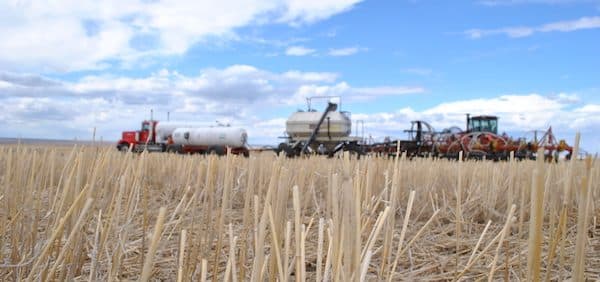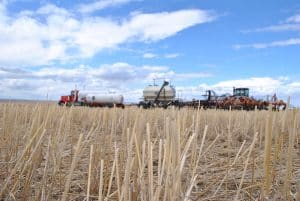Growers cultivating, discing and harrowing fields this spring may ask themselves “Why?” (This is a good test question for any practice.) Are the reasons still valid for current conditions? Is there a better alternative?
Here are 10 things to keep in mind when facing the decision to till or not:
1. Clubroot spreads with the movement of soil, either clinging to machinery or on the wind. Tillage moves more soil than any other practice. Reducing tillage will reduce the risk of moving clubroot.
2. Tillage can dry out the seedbed. A single pass with the drill is probably the best plan when topsoil is already dry. Even in wet soil conditions, spring tillage to dry it out can create a bigger mess than nothing at all. Hard clods from spring tillage in wet conditions make for a worse seedbed.
3. Tillage can help with a crop residue distribution issue, but for many production zones this is a bandaid solution for a situation often fixed with higher swathing/cutting heights, good combine spreading and other harvest management decisions. Also note that knocking down standing stubble with harrows may create more residue issues. Many drills are designed to seed through standing stubble.
4. If you can seed instead of till, why not just seed?
5. Harvest and spraying in a wet fall can leave ruts. Spring tillage can smooth out these ruts, improving field working conditions for the whole season.
6. Tillage can be part of an integrated weed management program, but herbicide rotation and tank mixing are effective tools to control weeds and prevent herbicide tolerance. If tillage is used, consider concentrating the work on problem weed patches only.
7. Reduced tillage saves diesel fuel.
8. Reduced tillage maintains carbon sequestration and improves overall sustainability of our production practices, giving Canada a competitive advantage.
9. Frost damage to canola seedlings can be more severe on residue-covered fields when frost comes after a warm sunny day. The difference is likely due to lower heat radiation in the critical early morning period under residue-covered soil compared to bare soil. While tillage is not a recommended frost management practice, the small amount of ground disturbance during the seeding pass could help. Research by AAFC in the Peace River region found that a narrow strip of bare soil over the seedbed can overcome most of the cold temperature and excessive moisture disadvantage of direct seeding in unfavourable situations. This is from the Canola Encyclopedia.
10. While growers in heavy production areas within the Black Soil Zone may see tillage as an essential part of their program, especially in wet cycles, tillage passes could be cut out of the program when the moisture situation changes.
U of S prof Jeff Schoenau, who has done tillage research and farms in Saskatchewan, makes the following useful statement about tillage:
“I think the wet conditions have stimulated interest in tillage particularly to reclaim areas flooded by excess water that have gone to weeds and cattails. Given a return to normal drier conditions, I think that the tillage will slow down. I do not see no-till diminishing, simply because of the efficiency it provides. There may be instances on a farm where a tillage operation is warranted — such as reclaiming flooded areas, smoothing wheel tracks, dealing with excessive uneven residue where the only alternative is burning, and as another means of dealing with herbicide-resistant weeds. From our work (see below), all is not lost if a single tillage operation is completed within a no-till system. Unless that single tillage operation resulted in severe erosion, it would seem that it would take several operations or large disturbance in the operation to produce measurable changes.”
Here is the abstract from the published study Schoenau cited:
C.D. Baan, C.J. Grevers, and J.J. Schoenau, 2009. Effects of a Single Cycle of Tillage on Long-term No-till Prairie Soils. Canadian Journal of Soil Science, 89, 521-530
Abstract: A study was conducted to examine the effect of tillage on soil conditions and crop growth at three long-term (> 10 yr) no-till sites, one in each of the Brown, Black, and Gray soil zones of Saskatchewan. The four tillage treatments consisted of one cycle of tillage at three levels of intensity: spring cultivation only, fall + spring cultivation, and fall + spring + disc cultivation, all applied to no-till and also a no-till control. Total and particulate soil organic carbon, soil pH, and soil aggregation were not affected by the tillage operations. Tillage decreased the bulk density in the 5- to 10-cm soil depth, but did not affect soil water content (0-10 cm) or spring soil temperature (0-5 cm). Tillage decreased stratification of available phosphorus to some extent, but there appeared to be no associated effect on crop P uptake. Tillage did not effect crop production in any of the 3 years following its imposition, except at one site where, in the first year, apparent tillage-induced nutrient immobilization resulted in lower yields. Overall, the imposition of one cycle of tillage on long-term no-till soils appears to have little effect on soil properties or crop growth.
This document provides a good overview of the research into conservation tillage in Western Canada, highlighting other considerations including nutrient availability and sustainability benefits.


